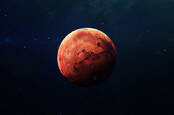Captain, the computer has identified 250 alien stars that infiltrated our galaxy – actual science, not science-fiction
Neural network trained to spot emigrated suns in our Milky Way uncovers mysterious Nyx collective
Deep-learning software has singled out a group of 250 stars in the Milky Way that appear to have been born outside our galaxy. That's according to a research paper published this week in Nature Astronomy.
The oddballs, known collectively as Nyx, were described as a “vast stellar stream in the vicinity of the Sun,” by Lina Necib, first author of the paper [pre-print] and a postdoctoral scholar in theoretical physics at Caltech.
However, unlike our own star, these suns don’t look like they really belong in the Milky Way.
The Nyx collective moves through the galaxy in a manner unlike nearby stars, and some stars in the group have a similar chemical composition that suggests the Milky Way inherited these stars when it merged with a dwarf galaxy in its past.
The Caltech team discovered Nyx by running stars observed by ESA's Gaia spacecraft through a neural network. Specifically, they used a model that had been trained to predict whether a given star has an intergalactic origin from its kinematics. The network was taught using synthetic data derived from simulations run by the Feedback in Realistic Environments (FIRE) project. Thus when the neutral net was shown real stars, it could attempt to predict, from their movements, whether they came from beyond the Milky Way.
The team were mindful they had to ensure their resulting AI system was grounded in reality, and reflected how the Milky Way actually worked, rather than predicting what would happen in a simulator. This was accomplished by incorporating real stars into the training process using transfer learning.
We worry that machines trained on them may learn the simulation and not real physics
“At the LHC, we have incredible simulations, but we worry that machines trained on them may learn the simulation and not real physics," said Bryan Ostdiek, co-author of the paper, a postdoctoral researcher at Harvard University, and previously worked on the Large Hadron Collider. "In a similar way, the FIRE galaxies provide a wonderful environment to train our models, but they are not the Milky Way. We had to learn not only what could help us identify the interesting stars in simulation, but also how to get this to generalize to our real galaxy."
They assigned the stars in the training data labels to indicate whether they were born in their galaxy, or accreted there as a result of a galaxy merger. After they trained their neural net, the academics fed it real data taken from the Gaia spacecraft to see if those observed suns were foreign to the Milky Way or not.
“We asked the neural network, ‘based on what you've learned, can you label if the stars were accreted or not?’” said Necib.
For each given star, the neural network generates a number between zero and one to indicate the likelihood it was formed inside the virtual model of the Milky Way or outside of it, respectively. To test their predictive model's accuracy, they checked if it was able to identify a separate group of stars known come from a separate galaxy merger some six to ten billion years ago. The foreign stars from that mash-up form what the scientists called a “Gaia sausage.”
Indeed, their model highlighted the Gaia sausage of stars – and a previously unknown group.
Your first instinct is that you have a bug
"Your first instinct is that you have a bug," Necib said. "And you're like, 'Oh no!' So, I didn't tell any of my collaborators for three weeks. Then I started realizing it's not a bug, it's actually real and it's new." She named the group Nyx.
“Nyx exists, there is no question about it,” she told The Register. “We can still debate its interpretation, as we are still gathering data to confirm the origin of these stars, but the machine-learning algorithm helped us identify these as interesting stars.
"We later studied their kinematics and indeed they are different from those of the [Milky Way's] disk; they have highly eccentric orbits, and lag behind the disk by about 90 kilometres per second, which is highly unusual for disk stars, even after collisions.”

Here's a headline we'll run this century, mark our words: Alien invaders' AI found on Mars searching for signs of life
READ MORE
The astrophysicists were hesitant to say these stars were definitely formed outside of our galaxy, and are the result of a dwarf galaxy merger, though they believe there is enough evidence to speculate that’s the case.
It’s possible, but unlikely, the model is incorrect, Ostdiek told The Register: “For any given star within Nyx, it is possible that the network is wrong about it. However, there are hundreds of stars which seem to be moving together and are all selected by the network. The network itself only identifies individual stars, not whole streams. The stars that it finds interesting are there, and are moving together.”
Necib said that to confirm whether the Milky Way did collide with a mystery dwarf galaxy in its past, they would have to study other sources of data: “We further need high-resolution spectroscopy to evaluate the chemical abundances of the Nyx stars. We expect these abundances to be different for disk stars compared to dwarf galaxies.” ®
https://www.theregister.com/2020/07/08/ai_galaxy_gobble/
https://www.theregister.com/2020/07/08/ai_galaxy_gobble/
No comments:
Post a Comment